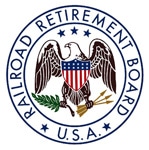The 2022 fiscal year budget proposed by the Biden administration May 28 offers a net increase in funding to the Railroad Retirement Board (RRB) to cover accumulating administrative costs and to improve customer service.

In its budget request to U.S. House leadership and to Vice President Kamala Harris, RRB reported that it has a staffing deficit of 12% from its minimum levels and that the RRB’s programs office has been operating at a reduced capacity because funding for the agency has been nearly flat for five years. Its workforce also is aging, with nearly a quarter of its workers now eligible to retire and 231 employees eligible to retire in the next year.
The added funding will allow RRB to increase its ranks to 801 full-time employees at a time when it needs workers to take care of retirement, survivor claims and numerous other customer-facing duties that had been hampered by the COVID-19 pandemic and chronic understaffing. In its budget request, RRB reported that just 35% of the 1.2 to 1.3 million calls its Bureau of Field Services received were answered in FY2020.
“We are operating in a transitional state that requires a sufficient investment in staffing to sustain benefit determination and payment operations, which still rely heavily on manual processing, while ensuring that the agency retains the knowledge of our laws and systems critical to modernizing benefit payment systems,” the agency stated. “The RRB believes that an increase in staffing is critical to the success of the agency over the next few years.”
The budget request is not the only way the current administration is working to improve RRB.
The agency’s years-long project to upgrade its IT infrastructure finally received full funding through Biden and Congress’s American Rescue Plan. The agency said that the modernization of RRB’s systems should also help to open the door to better service and more efficiency once fully implemented.
“We are grateful to the Congress for providing annual and supplemental appropriations that have fully funded RRB’s IT Modernization program,” RRB stated.
Read the RRB’s budget request and its 2022 Fiscal Year performance plan.
Tag: budget request

“Infrastructure deterioration and changes in business patterns have reached a point where something has to change,” said President and CEO Joe Boardman. “If America wants a modern intercity passenger rail system, the problems of policy and funding must be addressed.”
“Increased ridership, enhanced operating performance and stronger financial management are part of an improving Amtrak. It is time to consider a new paradigm for federal financial support,” said Tony Coscia, Amtrak board chairman. “The reality is that status quo federal funding levels put the Northeast Corridor infrastructure at increased risk of major failure with serious economic consequences for the nation.”
“The nation cannot afford to let a railroad that carries half of Amtrak’s trains and 80 percent of the nation’s rail commuters fall apart,” Boardman stressed, noting the NEC is vital to the mobility, connectivity and economy of the entire Northeast region.
Boardman explained a new federal policy and funding arrangement should create a significant and reliable multi-year capital investment program to reverse the decay of NEC infrastructure and support other intercity passenger rail projects. A strong federal commitment will allow Amtrak to plan and implement major multi-year projects such as replacing century-old NEC bridges and tunnels, and make critical capacity improvements such as the Gateway Program between New Jersey and New York.
Boardman said that NEC revenues exceed operating costs by more than $300 million a year and are today used to cover some costs of state-supported and long-distance trains. To provide additional funding for NEC improvements, Congress should fully fund the operating and capital needs of the long-distance routes so the NEC revenues can be reinvested in the NEC.
By dedicating NEC revenue to meet NEC needs, it could be leveraged to pay for debt service on loans to address the most urgent NEC infrastructure issues. It also could be used to finance other funding solutions such as public-private partnerships, grants of assistance, and state and commuter rail agreements.
Boardman said long-distance trains have been a core federal responsibility since 1971, and Congress should fulfill its obligation by funding their full cost. Long-distance trains form the backbone of the Amtrak national system, connect small towns to major cities, support local economic development, deliver passengers to state-supported corridor trains and conduct interstate trade and commerce. They are vital to the communities and people they serve, and increasingly important as airlines and bus companies abandon significant regions of America.
“It is clear that Americans want a national system of intercity passenger rail, and will continue to use it in greater numbers if we can provide it,” said Boardman. “Our work over the past decade proves this, but to maintain and improve that system will require both an increase in the overall capital levels and a real federal commitment to deliver the needed financing.”
For Fiscal Year 2015, Amtrak is requesting $1.62 billion in federal capital and operating support, an increase of approximately 16 percent from Fiscal Year 2014 federal appropriations.
A NEC Infrastructure Advisory Commission report details the growing risk to critical NEC infrastructure. A copy of the Amtrak FY 2015 budget request is attached.